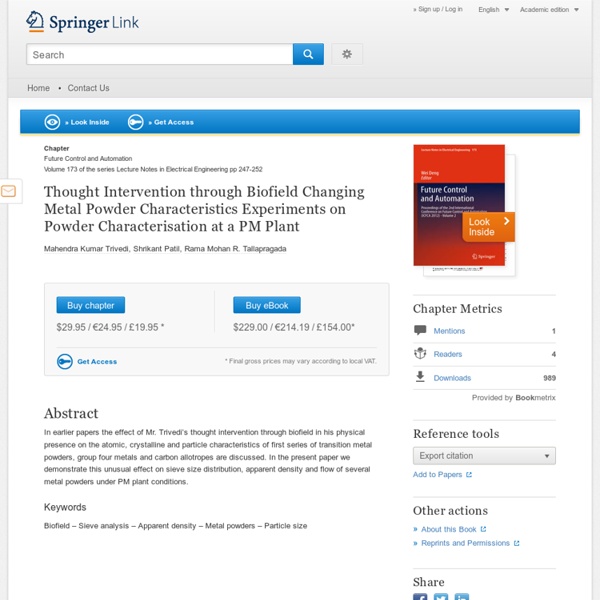



http://link.springer.com/chapter/10.1007%2F978-3-642-31003-4_31#page-1
Spectroscopic Characterization of Disulfiram and Nicotinic Acid after Biofield Treatment Trivedi, M. K. (2015), 'Spectroscopic Characterization of Disulfiram and Nicotinic Acid after Biofield Treatment'. %0 Thesis %1 mahendrakumartrivedi %A Trivedi, Mahendra Kumar %B Spectroscopic Characterization of Disulfiram and Nicotinic Acid after Biofield Treatment %D 2015 %I Mahendra Kumar Trivedi %J Analytical & Bioanalytical Techniques %K biofield mahendrakumartrivedi myown %N 5 %T Spectroscopic Characterization of Disulfiram and Nicotinic Acid after Biofield Treatment %U %V 6 %X Disulfiram is being used clinically as an aid in chronic alcoholism, while nicotinic acid is one of a B-complex vitamin that has cholesterol lowering activity. The aim of present study was to investigate the impact of biofield treatment on spectral properties of disulfiram and nicotinic acid.
User:Mahendra Kumar Trivedi The Trivedi Effect, Henderson, USA Mr. Mahendra TrivediFounder and Chairmen Affiliation: Trivedi Global Inc., 10624 S Eastern Avenue Suite A-969, Henderson, NV 89052, USA "Antimicrobial Sensitivity Pattern of Pseudomonas fluorescens after Bio" by Mahendra Kumar Trivedi Abstract Global emergence of Pseudomonas fluorescens (P. fluorescens) displays a mechanism of resistance to all existing antimicrobials. Due to its strong ability to acquire resistance, there is a need of some alternative treatment strategy. Objective of this study was to investigate the effect of biofield treatment on antimicrobial sensitivity pattern of P. fluorescens. P. fluorescens cells were procured from MicroBioLogics in sealed packs bearing the American Type Culture Collection (ATCC 49838) number.
Publication meta - Antimicrobial Sensitivity, Biochemical Characteristics and Biotyping of Staphylococcus saprophyticus: An Impact of Biofield Energy Treatment Staphylococcus saprophyticus (S. saprophyticus) is a frequent cause of urinary tract infection in the young women. The current study was designed to analyze the effect of biofield energy treatment on S. saprophyticus for evaluation of its antibiogram profile, biochemical reactions pattern and biotyping characteristics. Two sets of ATCC samples were taken in this experiment and denoted as A and B. Sample A was revived and divided into two parts Group (Gr.I) (control) and Gr.II (revived); likewise, sample B was labeled as Gr.III (lyophilized).
Spectroscopic Characterization of Disulfiram and Nicotinic Acid after Biofield Treatment *The embed functionality can only be used for non commercial purposes. In order to maintain its sustainability, all mass use of content by commercial or not for profit companies must be done in agreement with figshare. Description Disulfiram is being used clinically as an aid in chronic alcoholism, while nicotinic acid is one of a B-complex vitamin that has cholesterol lowering activity. Scopus - Welcome to Scopus You are outside your institution's network. To access Scopus consider the following options: Athens and Shibboleth (Institutional) users please login here. If you have previously registered with Scopus or ScienceDirect and your account is validated for remote access, you can login with your username and password. If your account is not validated for remote access, you may need to contact your institution's Scopus administrator (e.g. librarian) to have remote access enabled for your account. Alternatively, you may be able to gain access through your library's website or institution's VPN.
Effect of Biofield Treatment on Barium Titanate Powder Abstract Barium titanate, perovskite structure is known for its high dielectric constant and piezoelectric properties, which makes it interesting material for fabricating capacitors, transducer, actuator, and sensors. The perovskite crystal structure and lattice vibrations play a crucial role in its piezoelectric and ferroelectric behavior. In the present study, the barium titanate powder was subjected to biofield treatment. Further, the control and treated samples were characterized using X-ray diffraction (XRD) and Fourier transform infrared spectrometer (FT-IR) and Electron spin resonance (ESR).
"Antimicrobial Sensitivity, Biochemical Characteristics and Biotyping o" by Mahendra Kumar Trivedi Abstract Staphylococcus saprophyticus (S. saprophyticus) is a frequent cause of urinary tract infection in the young women. The current study was designed to analyze the effect of biofield energy treatment on S. saprophyticus for evaluation of its antibiogram profile, biochemical reactions pattern and biotyping characteristics. Publication meta - Spectroscopic Characterization of Disulfiram and Nicotinic Acid after Biofield Treatment - Publications - MyScienceWork Disulfiram is being used clinically as an aid in chronic alcoholism, while nicotinic acid is one of a B-complex vitamin that has cholesterol lowering activity. The aim of present study was to investigate the impact of biofield treatment on spectral properties of disulfiram and nicotinic acid. The study was performed in two groups i.e., control and treatment of each drug.
Trivedi Effect for iOS Pros In this app the latest information and online video can be seen. Cons Atomic and Crystalline Characteristics of Zirconia and Silica Powders Abstract Zirconium oxide and silicon dioxide powders are selected and subjected to a non-contact Biofield energy known to be transmitted by Mahendra Kumar Trivedi. Particle sizes d50 and d99 showed up to 71.5 percent decrease indicating that the energy had caused deformation and fracture as if the powders have been subjected to high energy milling. This is also supported by increase in specific surface area up to 19.48 percent. In the present investigation Zirconium oxide and silicon dioxide powders are exposed to Bio-field. Antimicrobial Sensitivity, Biochemical Characteristics and Biotyping of Staphylococcus saprophyticus: An Impact of Biofield Energy Treatment Title: Antimicrobial Sensitivity, Biochemical Characteristics and Biotyping of Staphylococcus saprophyticus: An Impact of Biofield Energy Treatment Updated: November 13th, 2015 Abstract: Staphylococcus saprophyticus (S. saprophyticus) is a frequent cause of urinary tract infection in the young women. The current study was designed to analyze the effect of biofield energy treatment on S. saprophyticus for evaluation of its antibiogram profile, biochemical reactions pattern and biotyping characteristics.